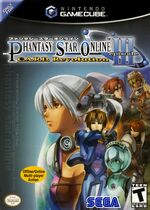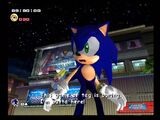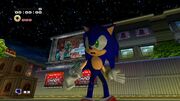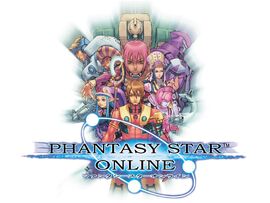Phantasy Star Online is an online RPG series created by SEGA originally for the Dreamcast, although it has spread out to other various systems. It is an offshoot of SEGA's original series Phantasy Star and most of the games play like a typical hack and slash RPG. There have been a total of 10 different versions games in the series. Each game has "Episodes", each episode having its own story line to follow. In total, there are four "episodes".
There have been four distinct game in the series, first beginning with Phantasy Star Online for the Dreamcast in 2000. Later, in 2002, SEGA released Phantasy Star Online Episode I & II for the Nintendo GameCube and Xbox, which contained the original story as well as an additional story episode. In 2003, Phantasy Star Online Episode III C.A.R.D. Revolution was released for the Nintendo GameCube, which changed the game formula from hack and slash to a turned base card game. Finally, in 2004, a port of the Xbox was disputed online as Phantasy Star Online: Blue Burst, a port which contained both Episodes I, II and a newly created Episode IV.
While none of the game's versions are officially supported by SEGA anymore, with the official servers having being taken down, it is still played on unofficial servers.
Plot[]
The Phantasy Star Online series takes place on a fictional planet, Ragol and the desperate attempt by the people aboard the spaceship Pioneer II to colonize the planet. There are four different episodes in the story line, spanning a time of 21 years. (Note: Although it is titled Episode IV, it occurs chronologically prior to Episode III. Upon its creation, SEGA claimed that Episode III would be the final episode in Phantasy Star Online's story arcs. However, with the release of Blue Burst a year later, Episode IV was added)
- Episode I: Seven years after Pioneer I landed on Ragol to colonize the planet, Pioneer II finally arrives in orbit around the planet. While preparing to land, a large explosion rocks the surface of Ragol and cuts off any communication between Pioneer II and the colonists down below. The Principal of Pioneer II issues the order that Pioneer II shall remain in orbit until what happened on the surface could be understood. In an attempt to discover the cause of the explosion, the Principal enlists the help of Hunters to explore the surface of Ragol for clues about the mysterious explosion and the whereabouts of his daughter, Rico Tyrell.
- Episode II: Takes place shortly after Episode I. The discovery of a formerly unknown laboratory on Gal Da Val island peeks interest in Pioneer II's government and once again recruits the hunters for help. While searching the newly discovered area, mysterious voice fragments of Healthcliff Flowen, a military commander presumed dead by the government, are uncovered. Using these messages as a map, the hunters now both explore the mysterious new laboratory, as well as discover the fate of Healthcliff Flowen and the terrible plan of Dr. Osto.
- Episode IV: Takes place about 2 years after Episode II. Still searching for a place to land to begin colonization, a comet en-route for Pioneer II is deflected by the ship, causing it to smash into the surface of Ragol with terrible force. From the mysterious crash, large amounts of photon were detected, causing Pioneer II to take interest. The Principal once again calls upon the hunters to travel into the crater to research the effects of the recent asteroid collision.
- Episode III: Takes places 21 years after the events of Episode II. Pioneer II's government, which is now independent from Coral, is filled with inner strife over to exploit the resources on Ragol, which would keep them from colonizing the planet. Among them is a a mysterious "germ" which was used to create the new C.A.R.D. technology. The Hunters, a government run organization that was created with the purpose in mind to research and find the source of the "germ", is now within conflict with the terrorist organization Arkz, who oppose any means to exploit the mysterious new substance.
Modes of Play[]
On all but Phantasy Star Online: Blue Burst, each PSO game offered both an Offline and Online story mode. There are also two extra modes, Challenge and Battle.
- Offline: When a player chooses Offline, he or she begins to play through the plot of the game. In all but Episode III, the story normally consists of the player running through a series of different levels in an attempt to discover how or why a person vanished. Episode III's offline story deals with a struggle between Pioneer II's government and a terrorist organization, Arkz. Aside from the story driven aspect of the game, players offline can take in quests which dive deeper into various back-stories of NPCs which can unlock weapons or assistance from various NPCs.
- Online: Online Mode differs from Offline in that it trades away the plot aspect in order to have the player travel online to play with up to three other hunters through the games story lands. In order to get online, a subscriber must sign up with SEGA's online program and get a Hunter's License with the serial number and code that is in each Phantasy Star Online box. Once online, the player can create a game in a lobby or join a game already in progress and play through the games story or do various quests with other players.
- Challenge: Aside from Offline and Online, a player can choose to enter Challenge Mode, a mode in which the player is stripped of all their current items and levels and forced to play through levels with certain requirements in order to complete it. If any member of the team dies, the player is forced to start over again. Upon completion of Challenge Mode, the player is awarded a weapon that they themselves can choose the name of.
- Battle: Battle mode is a death match showdown in which at least two players go up against one another and attempt to kill each other. It is the only mode where the team is allowed to attack one another and rules can be changed by the leader of the party.
Communication[]
In order to communicate online, SEGA created a virtual keyboard which could hold up to two lines of digital text. Aside from the keyboard, a player could use Symbol Chat, a collection of symbols within a speech bubble, in order to convey an emotion or simple instruction. These symbols could then be invoked via a player-defined shortcut, or accessed via an in-game menu. Another choice was Word Select in which a player could choose from a large list of phrases and words already imputed into the game. These words and phrases would be automatically translated into other languages, bridging the language divide. If a player bought a keyboard for the game, they could also do various actions in the lobbies by holding either the Alt or Shift key and pressing a number or letter. By holding the Alt key they will preform gestures of their characters current sex and will perform gestures of the opposite sex by holding the Shift key.
Game Versions[]
| Version | Platform | Release Date |
|---|---|---|
| Phantasy Star Online Network Trial Edition | Sega Dreamcast | Q3 2000 (Japan) |
| Phantasy Star Online | Sega Dreamcast | 21 November 2000 (Japan) 29 January 2001 (North America) 23 February 2001 (Europe) |
| Phantasy Star Online Ver. 2 | Sega Dreamcast | 6 June 2001 (Japan) 24 September 2001 (North America) 1 March 2002 (Europe) |
| Phantasy Star Online Beta | Microsoft Windows | Q4 2001 (Japan) |
| Phantasy Star Online | Microsoft Windows | 20 December 2001 (Japan) 2002 (Asia) |
| Phantasy Star Online Demo | Microsoft Windows | 20 December 2001 (Japan) January 2002 (UK) |
| Phantasy Star Online Episode I & II Trial Edition | Nintendo Gamecube | May 2002 (Japan) |
| Phantasy Star Online Episode I & II (ver 1.0) | Nintendo Gamecube | 12 September 2002 (Japan) |
| Phantasy Star Online Episode I & II (ver 1.1) | Nintendo Gamecube | 29 October 2002 (North America) November 2002 (Japan) 7 March 2003 (Europe) 14 March 2003 (Sweden) |
| Phantasy Star Online Episode I & II | Microsoft Xbox | Q1 2003 (Japan) 15 April 2003 (North America) 23 May 2003 (Europe) |
| Phantasy Star Online Episode III C.A.R.D. Revolution Trial Edition | Nintendo GameCube | June 24 2003 (Japan) |
| Phantasy Star Online Episode III C.A.R.D. Revolution | Nintendo GameCube | 27 November 2003 (Japan) 2 March 2004 (North America) 18 June 2004 (Europe) |
| Phantasy Star Online Episode I & II Plus | Nintendo Gamecube | 27 November 2003 (Japan) 15 September 2004 (North America) |
| Phantasy Star Online: Blue Burst Beta | Microsoft Windows | 21 May 2003 (Japan) 10 May 2004 (North America/Europe) |
| Phantasy Star Online: Blue Burst | Microsoft Windows | 15 July 2004 (Japan) 23 June 2005 (North America/Europe) |
| Phantasy Star Online: Episode IV Beta | Microsoft Windows | November 2004 (Japan) |
| Phantasy Star Online: Episode IV | Microsoft Windows | Q1 2005 (Japan) |
Media in the Series[]
Games[]
| Image | Name | Platform | Released |
|---|---|---|---|

|
Phantasy Star Online | Sega Dreamcast | December 21, 2000 |

|
Phantasy Star Online Episode III C.A.R.D. Revolution | Nintendo GameCube | November 27, 2003 |

|
Phantasy Star Online: Blue Burst | PC | June 1, 2004 |

|
Phantasy Star Zero | Nintendo DS | December 25, 2008 |
Printed Media[]
| Image | Name | Format | Released |
|---|---|---|---|

|
Phantasy Star Online Episode III C.A.R.D. Revolution & Phantasy Star Online Blue Burst Episode IV Visual Book | Art book | April 28, 2007 |
Soundtracks[]
References in other media[]

A billboard of Phantasy Star Online on the DC Sonic Adventure 2

A billboard of Episode I & II before fighting Big Foot
- In Sonic Adventure 2, there are several billboards around City Escape that advertise Phantasy Star Online. The Dreamcast versions of the game depict the original release, while the GameCube and PC versions showed off Episode I & II.
- In the same game, Sonic and Shadow were able to unlock Phantasy Star Online themed costumes by collecting all of their respective emblems. On the Dreamcast, Sonic's outfit was the default HUmar, while Shadow wore a red-themed HUcast costume. For the GameCube and PC rereleases, they changed to racing themed suits.
- In the video game, Dota 2, there are several references to Phantasy Star Online, namely with the weapons Sange and Yasha. Interestingly enough, like in PSO, Sange and Yasha can be combined.
- Other Phantasy Star Online weapon references in Dota 2 are found in the two similar themed bars, Monkey King Bar and Black King Bar. Although the Monkey King Bar may also be a reference to the classic story, Journey to the West, the Black King Bar is definitely a nod to PSO.
- In Sonic & All-Stars Racing Transformed, players are able to collect stickers by successfully completing certain in-game achievements. One sticker, called De Rol Le Credits, requires the player to unlock Superstar Showdown in World Tour mode, which then leads to a credits sequence. The sticker is a pun on the phrase "the rolling credits."
- Another sticker in the same game, called Star Phantasy, references the Phantasy Star franchise in general.
- The character Robo-Fortune from Skullgirls has two color palette skins that reference template characters, Elenor Camuel and Kireek, from Phantasy Star Online. The "Overclocked" palette's pink and white colors are reminiscent of the default RAcaseal. "Terror Byte" sports the iconic dark purple, white and black color scheme, as well as references Kireek's Viridia section ID with the green bell around her neck and her blood red tail hearkens to Kireek's deadly Soul Eater scythe.















